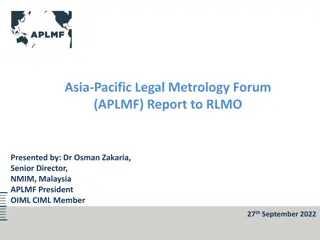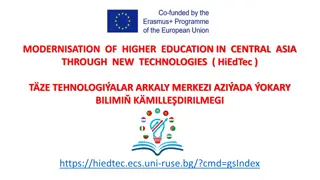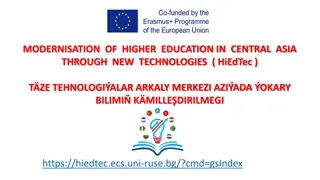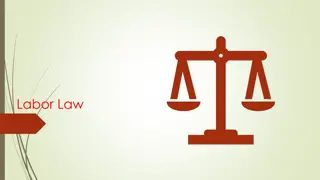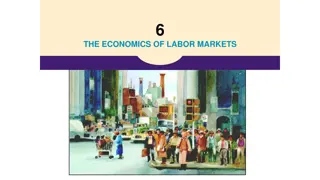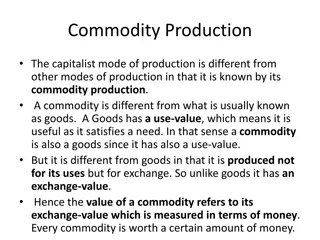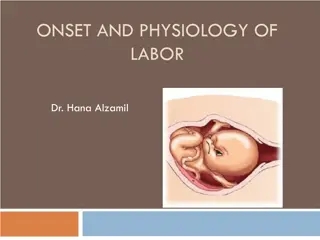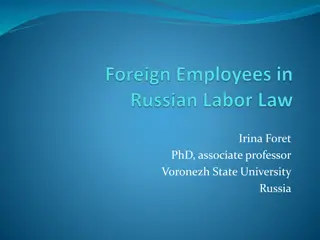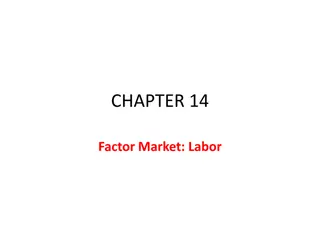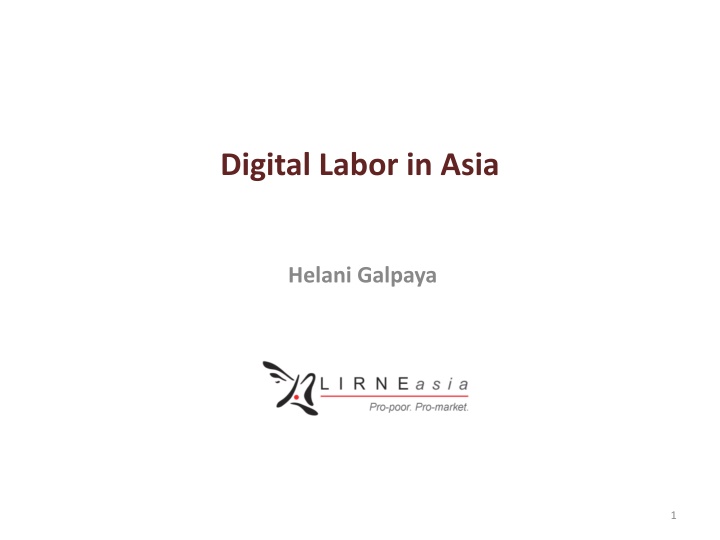
Digital Labor in Asia
This content delves into the various types of digital labor in Asia, encompassing informational, extractive, and industrial labor. It highlights the significant roles played by different forms of labor, touching on areas such as mining, manufacturing, and online platforms. The text showcases statistics and insights on the workforce involved in producing digital goods and services, shedding light on the complexities of this sector.
Download Presentation

Please find below an Image/Link to download the presentation.
The content on the website is provided AS IS for your information and personal use only. It may not be sold, licensed, or shared on other websites without obtaining consent from the author. If you encounter any issues during the download, it is possible that the publisher has removed the file from their server.
You are allowed to download the files provided on this website for personal or commercial use, subject to the condition that they are used lawfully. All files are the property of their respective owners.
The content on the website is provided AS IS for your information and personal use only. It may not be sold, licensed, or shared on other websites without obtaining consent from the author.
E N D
Presentation Transcript
Digital Labor in Asia Helani Galpaya 1
Labor involved in types of digital production (loosely modeled on Fuchs, 2013) --------------- Informational Labor -------------- Extractive Labor Industrial Labor Mining, smelting ICT manufacturing, assembly, foundry workers Type 1- S ware products, services Type 2 Freelancing, micro-work Type 3 producer- consumers Type of work Minors of tin, copper, gold, coltan, tungstan, cobolt Labor at FoxConn factories Labor at Apple, Microsoft, IBM, SAP, Infosys Labor via online platforms Freelancer, oDesk, Mechanical Turk, Google Ad Clicks - Users of Facebook, Twitter Example Call centers? - Block chain users Services that are impersonal (Blinder, 2007) Falling under to mode 1 trade (pure remote transaction where buyer/seller don t meet physically) 3
Difficult to quantify labor that is extracting only for digital goods, but signficant numbers employed % of world mine production, 2016, by volume # employees in leading rare earth element production in China Country United States South Africa Malawi Greenland Canada Vietnam Malaysia Thailand Brazil India Russia Australia China World total (rounded) 2016 0.0 0.0 0.0 0.0 0.0 0.2 0.2 0.6 0.9 1.3 2.4 11.1 83.3 Number of employees 290 Company China Non-Ferrous Metal Mining China Northern Rare Earth Group High-Tech Co Ltd Aluminum Corporation of China Limited China Minmetals Corporation Total for top 4 firms Source: Estimated by author, based on various sources such as https://markets.ft.com/data/equities/; https://en.wikipedia.org/wiki/Aluminum_Corporation_of_China_Limi ted; http://www.minmetals.com/english/about_666/AboutMinmetals/ 9,840 103,493 240,000 353,623 100.2 Source: U.S. Geological Survey, Mineral Commodity Summaries, January 2017
Industrial labor employs even more: Contract manufacturing is dominated by China Employees at Fortune 500 manufacturers @top contractor manufacturers of digital goods (2013) Employees in China, 2013 Employees in China 6,310 6,668 8,504 Contract manufacturers Hon Hai Precision Industry (Foxconn) Quanta Computer Pegatron Flextronics International Compal Electronics Wistron Jabil Inventec New Kinpo Group Celestica Sanmina Lite-On IT Qisda Shenzhen Kaifa Technology Benchmark Electronics Plexus Universal Scientific Industrial Arima Communications TOTAL Head office New Taipei, Taiwan Kuei Shan Hsiang, Taiwan Taipei, Taiwan Singapore Taipei, Taiwan Taipei, Taiwan St. Petersburg, FL, USA Taipei, Taiwan Taipei, Taiwan Toronto, Canada San Jose, CA, USA Taipei, Taiwan Taoyuan, Taiwan Shenzhen, China Angleton, TX, USA Neenah, WI, USA Shanghai, China Taipei, Taiwan Employees 1,290,000 121,917 177,948 149,000 43,000 60,000 121,000 3,729 80,000 29,000 43,000 35,000 8,000 - 10,000- - 60,000 4,459 2,226, 053 Kinpo Electronics, Inc. Optoelectronics Qisda Universal Sci-entific Industrial Co. Ltd. Shenzhen Kai-fa Tech- nology Co. Ltd. Wistron Quanta Computer Flextronics Jabil Pegatron Foxconn/Honhai 15,328 35,800 37,605 70,000 70,000 74,000 100,000 1,200,000 Employees in India, 2013 Employees in India Name Lite-On Mobile Sanmina Corporation Foxconn/Honhai Flextronics Jaqil 1,000 1,500 1,700 6,500 65,000 Source: Fortune Global 500 (http://fortune.com/global500/2013/) and companies annual reports
Information Labor : traditional IT sector employment Computer software and services employment as % of total employment % of total business sector workforce involved in the ICT sector 8% 0.8 7% 0.7 7% 0.7 6% 0.6 5% 5% 0.6 5% 0.5 3.8% 4% 0.4 0.4 3% 0.4 3% 0.3 2% 0.2 0.2 0.2 1% 0% 0.1 Thailand (2007) United States China and Hong Kong (2010) Singapore (2010) Malaysia (2007) 0 (2011) China Thailand Malaysia Malaysia India United States Number of employees in Computer Software and Services Malaysia Thailand India China 51,000.00 76,000.00 177,900.00 1,534,080.00 Source: http://unctad.org/en/PublicationsLibrary/ier2012_en.pdf
India: leader in traditional IT jobs Direct Employment ('000)* in IT BPM Sector in India 4000 3500 760 720 3000 700 2500 1090 ('000) 1040 990 2000 1500 1000 1840 1730 1600 500 0 2014 2015 2016E IT-BPM Domestic*** 700 720 760 BPM exports 990 1040 1090 IT exports** 1600 1730 1840
Domination through industry lobbying, government action (apart from labor arbitrage, educated workforce Emergence of strong lobbies: NASSCOM (India), SLASSCOM (Sri Lanka) Heavy lobbying E.g. Call by private sector for higher quality lower cost wholesale telecom connectivity in India, late 1990s and early 2000 Government convening stakeholders ID of core competency in accounting in Sri Lanka in early 2003-2004, investment in trade-shows to highlight outsourcing capabilities Incentives Tax breaks for foreign direct investment, full profit repatriation World s top Outsourcing Destinations for IT companies 1. India 2. China 3. Malaysia 4. Mexico 5. Indonesia 6. Thailand 7. Philippines 9
Information Labor non traditional platform labor Registered Freelancers, Elance Micro workers in Sri Lanka 17,000 22,000 649,566 700,000 600,000 500,000 400,000 300,000 178,725 200,000 Source: LIRNEasia (2017) based on national survey representative of 16-45 yr olds and author estimates 100,000 31,066 28,752 23,189 8,774 0 Thailand Sri Lanka China Malaysia Philippines India Source: https://www.elance.com/trends/talent-available/geo Column1 China India Malaysia Philippines Sri Lanka Thailand Online platforms: Freelancers in Upwork, 2013 251-2500 2,501-11,800 51-250 2,501- 11,800 251- 2500 51- 250 Source: Graham
Information Labor many prosumers in Asia, and growing Leading countries based on number of Facebook users (as at 04/2017) Year-on-year growth of social media users (as at 01/2017) Millions of users 219 213 123 111 76 63 50 48 47 42 1. United States 2. India 3. Brazil 4. Indonesia 5. Mexico 6. Philippines 7. Vietnam 8. Turkey 9. Thailand 10. United Kingdom Malaysia Thailand India China Philippines Sri Lanka 12% 18% 23% 28% 29% 46% https://wearesocial.com/special-reports/digital-in- 2017-global-overview Source: https://www.statista.com/statistics/268136/top- 15-countries-based-on-number-of-facebook- users/
MAPPING THE LITERATURE ON LABOR 12
Labor involved in types of digital production (loosely modeled on Fuchs, 2013) --------------- Informational Labor -------------- Extractive Labor Industrial Labor Mining, smelting ICT manufacturing, assembly, foundry workers Type 1- S ware products, services Type 2 Freelancing, micro-work Type 3 producer- consumers Type of work Minors of tin, copper, gold, coltan, tungstan, Cobolt (e.g. in DRC) Labor at FoxConn factories Labor at Apple, Microsoft, IBM, SAP, Infosys Labor via online platforms Freelancer, oDesk, Mechanical Turk, Google Ad Clicks - Users of Facebook, Twitter Example Call centers? - Block chain users 13
Information Labor can be further broken down --------------- Informational Labor -------------- Extractive Labor Industrial Labor Mining, smelting ICT manufacturing, assembly, foundry workers Type 1- S ware products, services Type 2 Freelancing, micro-work Type 3 producer- consumers Type of work Minors of tin, copper, gold, coltan, tungstan, Cobolt (e.g. in DRC) Labor at FoxConn factories Labor at Apple, Microsoft, IBM, SAP, Infosys Labor on online platforms Freelancer, oDesk, Mechanical Turk, Google Ad Clicks - Users of Facebook, Twitter Example Call centers? - Block chain users 50% of the world s manufacturing in China 14
Range of interconnected themes come up repeatedly Exploitation of labor (Lack of) collective power of digital labor Alienation Marginalization of specific groups 15
Exploitation existence of this is well covered, across all types of ICT labor In the extractive industries: Forced and under-aged/child labor in mining (World Vision, 2012) in African countries; Slavery in Congo (Leslie et al, 2011) In the ICT Assembly: Low pay, forced excessive overtime, hazardous working conditions/exposure to chemicals, excessive punishment (World Vision 2012) in China In call centers: not all gloom and doom Golpelwar finds compared to other service sector jobs, call centers employees in India did NOT experience higher levels of stress. But they were more stressed due to social pressures to conform In the Producer-Consumer ( prosumer ) sector Trend towards unpaid digital labor (Ritzer et al 2010) exhibiting characteristics of capitalism, control, exploitation Brown (2014) talks of unwaged digital labor characterized by 1) Its inherent autonomy (2) Its exploitative nature (3) Its instances of resistance and struggle (4) Its intrinsically collaborative and cooperative nature (5) Its bio political impact on the constitution of subjectivity 16
(Low) Collective power of labor highly differentiated skills have more power, commotized labor has less Difficult to establish collective power of labor or collective identity. due to: Workers are physically, administratively detached and de- synchronized from each other (Ashford, 2007) Labor locally fragmented (Castells, 2000); Coordination of workers and work is achieved algorithmically at times (O Reilly, 2013; Lehdonvirta, 2016)) Unions controlled by management, not allowed by state Chan (2013), studying Foxconn in China BUT algorithms also facilitate worker networks/connections, get social support (e.g. Lehdonvirta, 2016 in studying PH platform workers) 17
Alienation: much literature on the platform-end of digital labor. All workers exploited by capital are alienated from the products of their work Kruger & Johanssen (2014) speak of 4 dimensions of alienation (1) alienation from the material of one s labor, (2), alienation from the instruments, (3) alienation from the product(s), and (4) alienation from oneself Fuchs (2014) examines social media platforms to describe labor that is alienated due to: Coercion by isolation/social disadvantage if they leave the platforms (e.g. Facebook); Instruments of labor (the platform) not owned by user and user data commoditized by platform; Product of labor (money that is made) controlled by platforms Zwick (2008): participatory consumers are exploited because they do not realize the value they have added to the commodity via their participation Zittrain (2009) examines alienation where worker is unaware of the end result and the uses made of the products of labor E.g. identifying protestors in repressive regime by matching photos through distributed task on Mechanical Turk But admits certain platform labor as enabling high engagement and highly creative work. Andrejevic (2011) claims users recognize the results of their labor as their own on Facebook, You Tube etc. The fact that users are willing to customize platforms implies they are aware of alienation and are willing to do more to overcome it. Comor (2010) also sees the contradiction where the core motivation to take part is to redress one s own alienation A minority will even engage in economically creative, thoughtful forms of prosumption. Some potentially subversive. 18
Literature on alienation, on a spectrum No alienation Alienation exists & visible Zittrain (2009) Fuchs (2014) Andrejevic (2011) Kruger & Johanssen (2014) Comor (2010) Zwick (2008) 19
Marginalized group: differentiated experience (+ve or ve) based on group identity. Gender and geography Gender: Call centers mostly women (Belt, 2002; Cabrera 2005; Sibal 2006; Domingo- Cabarrubias, 2011) Feminization of labor market driven by demand for stereotypical feminine qualities ability to smile down the phone line (Best, 2002) Gender : generally that women experience benefits differently (and less so) than men due to various reasons Women consistently under-bidding for similar work compared to men (Galperin) Geography/race: Bias against labor from specific regions Against BD and PK workers and in favor of AU, UK (Beerepoot & Brantbegs, 2015) Country-based stereotypes of work quality (Galperin) Education: Hiring practices (bonuses to current employees for referrals) encourage maintenance of status quo in IN: educated, English-speaking (Upadya & Vasavi, 2006) But geographical arbitrage is also what allows employees of one country to capture welfare losses of another (Lehonvirta, 2016) 20
Skills and experience: Worker performing tasks no corresponding to level of skill (Graham, 2017) Skill and experience does not translate to higher wages (Beerepoot & Lambgrets) Skill and experience CAN translate to higher wages, if work is moved off-platform, soft-skills are used (Galpaya et al,2017) 21
Mapping types of labor to themes -------- Informational Labor--------- Theme Extractive Labor Industrial Labor Example Mining, smelting ICT Assembly, foundry workers Type 1- S ware products, services Type 2 Freelancing, micro- work Type 3 producer+ consumer Marginalized groups (e.g. by gender, geography) Fuchs (2013); Holman (2007); Cabarubbias (2013); Upadhya (2008); Arun (2002) Beerepoot (2014); Galperin (2017) Bargaining power Chan (2013) Lehdonvirta (2016) Staab & Nachtwey (2016); Graham (2017) Exploitation World Vision (2012) Chan (2013) World Vision (2012) Kruger (2014), Golpelwar (2012) Ritzer (2010); Brown (2014) Alienation Fuchs (2013) Chan (2013) Jaeggi (2005) Zittrain (2009) Comor (2010); Fuchs (2014); Andrejevic (2011); Zittrain (2009); Zwick (2008), Adrejevic (2011) Skills Graham (2017); Zittrain (2009) 22 Other Leslie (2011)
QUESTIONS 23
Gaps/things worth mulling over Poverty, resilience Smoothening of income (similar to mobile money) and increasing resilience? Economic impact quantified (most studies on MT workers in developed economies) Skills, sustainability of skill advantage Up-skilling, maintaining competitive advantage, moving to higher margin work (or larger pieces of work) does this happen? Are the higher margins sustainable? Emergence of the generalist is this what is happening? What impact on labor statistics? Soft skills and the role played in succeeding in digital labor Link between self-learning/MOOCs and success in /entry into modes of digital labor Inclusion is this more inclusive or less (of traditionally marginalized groups)? Why? Why is it that this is not attractive for women who leave the workforce to balance work/lfie? No on knows you are a dog on the Internet . So why not pretend to be someone else (e.g. a white male)? Can geographical stereotypes be overcome? Role of insurance in extending worker rights/safety nets What can we learn from SAG (USA), SEWA (India) and other irregularly employed groups FOR ABOVE ISSUES: are the answers different between mode pure digital labor (mode 1 trade) vs. labor that has features of physically colocation? 24
Gaps/things worth mulling over What being an employer means and what being an employee means Is it defined by protection (minimum wage, working time, non-discrimination, dismissals, collective rights etc.)? Ratti (2016) gives good summary of current thinking Both complicated by the collapse of geography No clear jurisdiction. Particularly relevant to developing countries In poorly governed countries with weal labor rights .digital better? 25
Issues faced by micro-workers, based on our field research Poor quality of internet, specially upload quality and throughput We need uplink [speeds]. Most provide download speed but upload is low. If we host a website, what we need is upload. Its difficult to do it here Affordability of Internet They [potential buyers] tell us to upload sample videos [before giving a job to create a video]. If we upload these samples, with the data that was used, the amount that we earn will be of no use. We can t tell them that this is the amount it will cost us to upload the video, etc. Inability to get payments: PayPal not legal in Sri Lanka They [the microwork site] told me to create a Paypal account. Which I did. I think the Paypal money cannot be withdrawn in Lanka. I asked local banks such as Hatton National Bank and Commercial Bank. What they said is that it cannot be done. The money cannot be withdrawn from Sri Lanka, it can be only done via Singapore. So, then I gave up on the idea of withdrawing that money 27
THANK YOU 28
About LIRNEasia Our mission: Catalyzing policy change through research to improve people s lives in the emerging Asia Pacific by facilitating their use of hard and soft infrastructures through the use of knowledge, information and technology. 29



